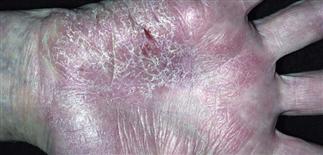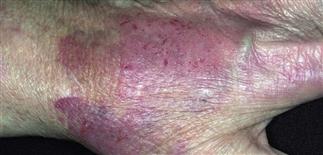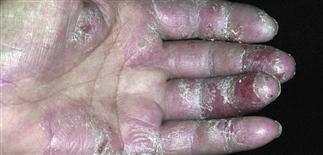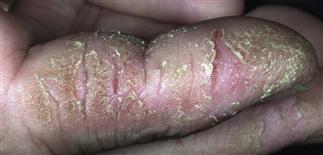Hand eczema

Hand dermatitis. Erythema of the palms, with a more focal area of scaling and pruritus. Search for irritants, allergens, and history of atopy. Consider occupational and other daily exposures.

Dorsum of the hand with patch of erythema, some crusted vesicles, and some scaling. Excoriation has caused the skin surface to break in several areas.

Dermatitis with erythema, scaling, and crusting on the palms and fingers. Consider irritants, allergens, exposures, and care regimen specifics in looking for causal or aggravating factors.

Erythema, yellow scaling, and fissuring characterize this more psoriasis-like dermatitis on the fingers.
DESCRIPTION
Common, often chronic, with multiple causative and contributing factors. • Types: irritant (most common) and allergic contact; atopic, keratolysis exfoliativa; fingertip; hyperkeratotic; nummular; pompholyx (dyshidrosis); and ‘id reaction’.
HISTORY
• Occupational risks: irritant exposure, frequent wet work, chronic friction, work with sensitizing (allergenic) chemicals. • Irritants: include chemical irritants (e.g. solvents, detergents, alkalis, acids), friction, cold air, low humidity. • Allergenic chemicals from occupational and/or non-occupational sources: immediate type 1 allergy (e.g. to latex, food proteins); delayed type 4 allergy can develop to rubber antioxidants and accelerators, nickel cobalt and chromium, medicaments (bacitracin, neomycin, hydrocortisone) and ingredients in skin products (e.g. preservatives, fragrances, sunscreens, other additives). • Id reactions: eczematous eruptions to distant fungal (dermatophytid) or bacterial (bacterid) infection. • Endogenous factors: atopic diathesis (allergic rhinitis, asthma, atopic eczema).
PHYSICAL FINDINGS
Variable presentation: acute, subacute, or chronic eczematous lesions. The following findings may prove useful. • Xerosis, erythema, burning > itching on dorsal or volar hands: evaluate for irritant or allergic factors. • Nummular eczema: allergy, irritation, or atopy can play a role; occasionally, contact urticaria (type 1 allergy) is culprit. • Recurrent, intensely pruritic vesicles on lateral fingers and palms: suspect pompholyx. • Fingertip eczema (dryness, splitting, tenderness, no itch): suspect an irritant, an endogenous factor (atopy during winter), or a frictional eczema. • Erythema, scaling, itching in ‘apron’ (base of the fingers) of palm: suspect atopy.
TREATMENT
• Frequent, generous application of a bland emollient (white petrolatum, Aveeno, Hydrolatum, Aquaphor). • Avoidance of irritants such as frequent hand washing and water exposure, soaps, detergents, solvents. If hand sanitizer can be used in place of washing hands, it is less irritating and should be recommended. Chronic frictional trauma also an irritant. • Take protective measures (e.g. vinyl gloves for wet or chemical work). • Medium- to high-potency (groups II–IV) topical steroids twice daily. Ointments preferred. Most effective when used intermittently. • For severe dermatitis, a superpotent topical corticosteroid applied after wet dressings containing Burow’s solution, twice a day for 3–5 days, followed by a medium-potency topical corticosteroid twice a day for several weeks. • Other options include topical tar hand soaks with Balnetar oil, two or three capfuls diluted in water for 15–30 min twice daily, followed by topical corticosteroid. • Systemic steroids (prednisone 0.75–1 mg/kg q.d., tapering over 3-week course) may occasionally be required. • Most improve with irritant avoidance, frequent emollient use, and occasional topical steroid treatment. • Refer to a dermatologist if chronic and refractory. • Patch testing indicated to evaluate for occupational and environmental allergens if recurrent.







